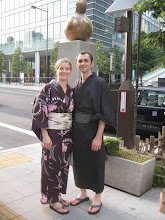My sisters came to visit us in August and we all decided that we would journey down from Tokyo to Hiroshima to see the A-bomb Museum and Memorial Center. I don't think I was quite prepared to see all that I saw. It could be easy to walk into that place and just numb out. It could be very simple to experience it only with your mind and not your emotions. After all, pushing your emotions aside would be the safe way to walk through such a museum. That way you don't have to deal with the questions that will inevitably come....God, why did you allow this?? Why are the hearts of man so evil?? As an American, how do I respond to this horror that we caused on a nation??
My tears flowed as I walked through each room. Being a mom has now made my heart more vulnerable, i think. My heart would ache and the tears would come very easily at the stories of children who were killed during the explosion of the bomb. After a while I had to take a break from listening to the stories on my headset. Whole families, bloodlines were wiped out. So many people suffered so terribly.
If it is ever possible for you to visit the Memorial Museums in either Nagasaki or Hiroshima I think it is necessary you do so. Every person should visit it so they can see the damage, horror, destruction done by the use of nuclear weapons.
Below are some pictures of our trip to the museum and Peace Memorial Park. We didn't take many pictures inside the museum because I think we just didn't think about it. I guess our minds were preoccupied.
A-bomb Dome: The Hiroshima Industrial Promotion Hall was constructed in 1915. On August 6, 1945 it was instantly destroyed by the first atomic bombing in human history. Flames enveloped the ceiling of the dome and consumed the entire building, killing everyone within. The parts of the walls, which withstood the blast because it came from above, together with the steel frame have become a symbol of Hiroshima. (taken from a brochure)

There were many strands of 1,000 cranes hung around the Memorial Tower to the Mobilized Students.

The Japanese have a legend that states that anyone who folds 1,000 cranes will be granted one wish. Sadako Sasaki was a small school girl who believed in this tale. She was diagnosed with leukemia as a result of the radiation from the atomic bomb. She tried to fold 1,000 cranes because she believed if she could then she would be healed. Sadako didn't live long enough to finish her goal. After her death, her school mates picked up where she left off and fulfilled her dream of making 1,000 cranes in her memory. Now, 1,000 cranes together has also become a symbol for peace.

Cenotaph for the A-bomb victims

This jacket was being worn by a female student when the bomb dropped.


A picture of the aftermath (1 of 2)

Continuation of previous picture (2 of 2)

A drawing in the museum. "Injured with Their Clothes Torn Apart and Skin Hanging Down" The artist said this, "The injured were silently escaping for the suburbs like ghosts along the bank with their hair disheveled, clothes torn apart, and skin hanging down. They looked like nothing on earth." Drawn by, Kichisuke Yoshimura

A model showing the hypocenter and the destruction. Homes were wiped away as though nothing had ever been there.

The warhead

"Shinichi Tetsutani (then 3 years and 11 months) loved to ride this tricycle. That morning, he was riding in front of his house when, in a sudden flash, he and his tricycle were badly burned. He died that night. His father felt he was too young to be buried in a lonely grave away from home, and thinking he could still play with the tricycle, he buried Shinichi with the tricycle in the backyard.
In the summer of 1985, forty years later, his father dug up Shinichi's remains and transferred them to the family grave.
The tricycle and helmet were donated to the Peace Memorial Museum." (taken from the plaque that accompanied the tricycle)

Glass jars that melted together instantly from the intense heat of the bomb.




No comments:
Post a Comment